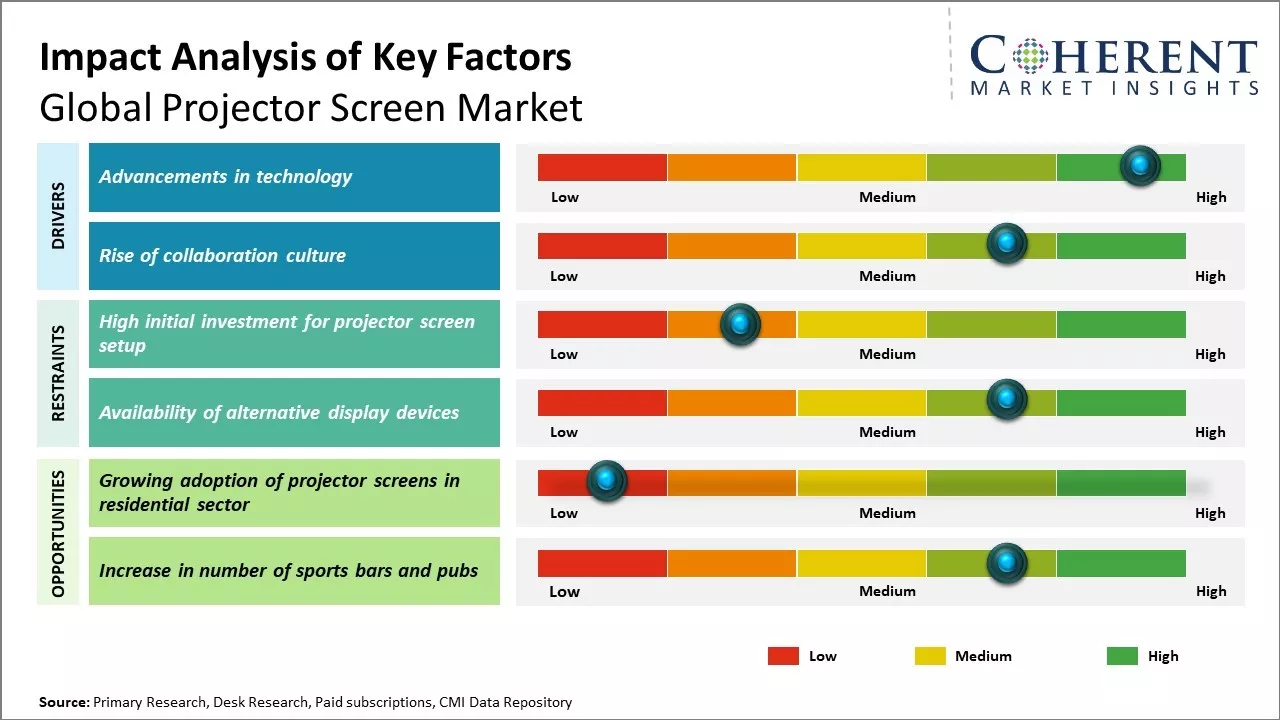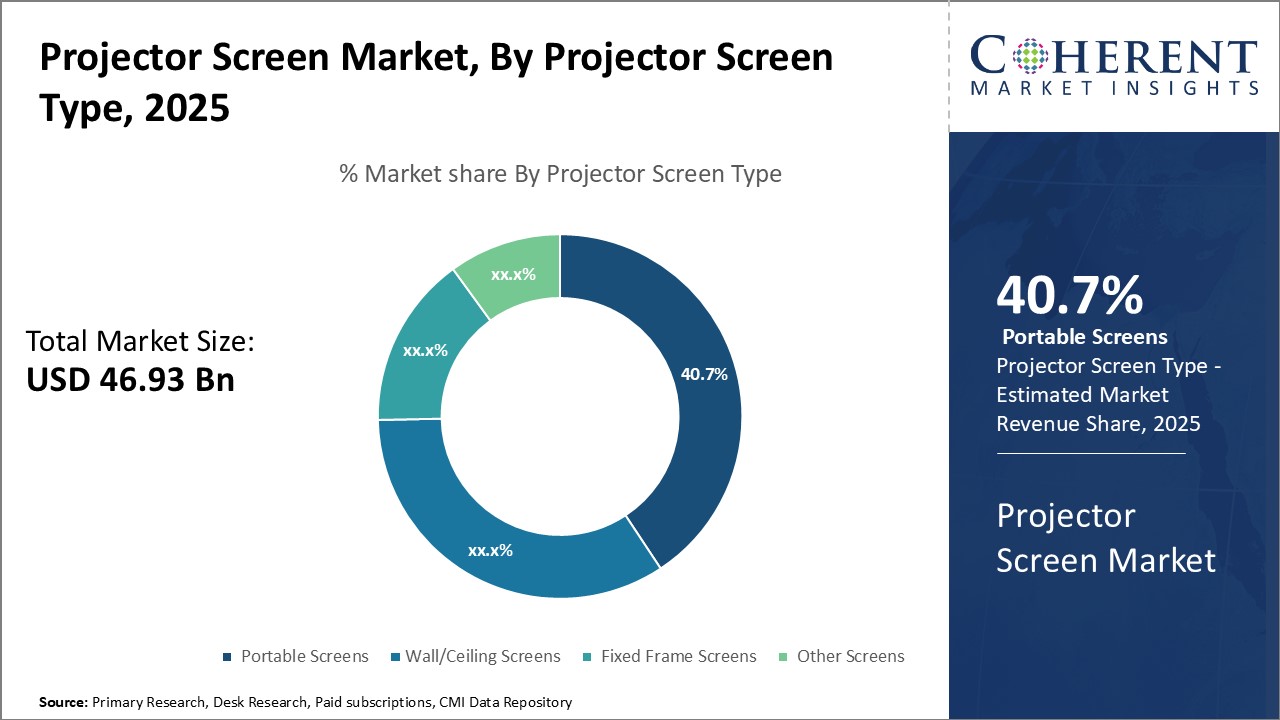The global projector screen market is estimated to be valued at US$ 46.93 Bn in 2025 and is expected to reach US$ 61.38 Bn by 2032, exhibiting a compound annual growth rate (CAGR) of 3.9% from 2025 to 2032.

Discover market dynamics shaping the industry: Download Free Sample
The projector screen market is expected to witness a positive trend during the forecast period. Technological advancements in projector screens focusing on resolution, brightness, and portability are enhancing end-user experience for various applications such as classrooms, corporate, and home entertainment. Major market players are investing in R&D to develop advanced projection screens such as the role and drape screen, fixed screens, and portable screens. Rising demand for enhanced viewing experience is boosting innovations and making projector screens multi-functional for flexible positioning during usage. Increasing commercial and residential construction as well as infrastructure development projects worldwide are envisioned to propel the sales of projector screens during the forecast period.
Advancements in technology
The global projector screen market is being positively influenced by the ongoing innovations and advancements in technology. Projector screens are increasingly getting smarter, portable and multi-functional. With technology getting more integrated into our daily lives, projector screens are moving beyond traditional stationary displays. Manufacturers are developing projector screens that can roll up like a poster and be carried anywhere conveniently. This has made projector screens more viable for on-the-go business presentations and conferences. Some screens even allow for wireless screen sharing and touchscreen capabilities directly from a mobile device.
Advanced coated materials are allowing manufacturers to produce projector screens that deliver impressive image quality regardless of ambient light conditions. Screens are available with extra wide viewing angles so that the content is visible from anywhere in the room. Self-install screens have simplified setup routines and reduced installation costs. Automated screen mechanisms are providing seamless lowering and risings according to requirement. Interactive screens are enhancing collaboration by enabling annotation directly over projected content. With innovations focusing on portability, versatility and easier usability, projector screens are finding more acceptance among professionals, educators and consumers who desire large shared displays for visual communication. The proliferation of smarter devices and connectivity solutions are creating new interactive experiences and driving the demand for advanced projection screens.

Get actionable strategies to beat competition: Download Free Sample
Rise of collaboration culture
Modern workplaces and learning environments are focusing more on collaboration to drive innovation, share knowledge, and solve problems collectively. This rising culture of collaboration is having positive implications for the global projector screen market. Projector displays are increasingly being deployed in medium to large conference rooms, huddle spaces, lecture halls, and co-working areas to encourage participative discussions. They provide a large centralized visual that can keep all attendees engaged on the same content. Projector screens allow teams to brainstorm ideas, review documents, and whiteboard sessions simultaneously. Businesses are recognizing their ability to remove communication barriers between distributed teams.
Educational institutions are also outfitting more classrooms with projector screens to supplement traditional whiteboards. Teachers can utilize rich multimedia content and online resources to enrich course delivery. Students benefit from life-size visuals to clarify difficult concepts. Screen sharing and annotation features foster active learning through collaborative exercises directly on the displayed content. Many organizations are realizing the potential of projector displays in integrating distributed workforces. Their deployments in video conferencing rooms and command centers ensure seamless participation of remote attendees.
Key Takeaways from Analyst:
The global projector screen market is expected to witness steady growth over the forecast period driven by rising adoption of advanced educational technologies in classrooms. Increased investments by governments worldwide towards the digitization of education is likely to boost the demand for projector screens. Rising number of corporate meetings and conferences that require large display solutions will also support the market growth. The work from home culture emerging due to the pandemic has further increased the need for projector screens as more people require home theater and cinema experience at home.
However, increasing popularity of smart TVs and large format LED and OLED displays may limit the demand for projector screens to some extent. Availability of cheaper Chinese products is also intensifying competition. Projector screens made from glass pose fragile nature which can hamper adoption rates. North America currently leads the global projector screen market owing to high technology adoption in educational institutions and corporate offices. Asia Pacific is anticipated to offer lucrative growth opportunities during the forecast period led by India and China on account of rapid digitalization of education sector.
In terms of segments, front projector screens are expected to remain the dominant category attributed to high compatibility with most projector models. Automatic projector screens are gaining popularity due to ease of use. key players could eye lucrative opportunities in the education segment through customized products and bundled offerings.
Market Challenges: High initial investment for projector screen setup
The high initial costs associated with projector screen setup is one of the major factors inhibiting the growth of the global projector screen market. Setting up a professional quality projector screen requires considerable financial investment, which many small businesses and individual consumers find prohibitive. Custom fabricated projector screens that offer optimal viewing experience and protection to the projector from external glare and flutters can cost thousands of dollars. Even basic pull-down screens from well-known brands demand an expenditure of several hundred dollars.
The high setup costs encompass not just the screen itself but also accessories needed for proper installation. A fixed frame screen needs to be securely mounted on ceiling or wall with appropriate mounting brackets and hardware. Portable electric screens require connection to a power outlet as well as controls for raising and lowering. Installation of these involves employment of professionals for measuring, marking and fitting as per space dimensions which drives up expenses further. Commercial projection systems employing large format screens exceeding 100 inches in size demand specialized motorized screens and control systems escalating the initial investment manifold.
Market Opportunities: Growing adoption of projector screens in residential sector
The adoption of projector screens in the residential sector has been steadily increasing over the past few years and provides a huge growth opportunity for the global projector screen market. With more people working from home and spending more leisure time at home due to the pandemic, home theatre systems have gained immense popularity.
Projector screens provide an immersive viewing experience for movies, TV shows, sports, and other content. While basic pull-down screens have been used in homes for many years, the demand for larger, motorized, and frameless projector screens that can retract into the ceiling or wall when not in use has risen sharply. These new generation screens with wider aspect ratios and specialized surfaces for ambient light rejection are ideal for modern living rooms. They have become a prominent part of home theatre designs conceived by interior designers. The trend is more prominent in developed nations where disposable incomes are higher and more homes are being built with dedicated home theatre spaces.

Discover high revenue pocket segments and roadmap to it: Download Free Sample
Insights By Projector Screen Type - Portability and Versatility Drive the Adoption of Portable Screens
In terms of projector screen type, portable screens is expected to contribute 40.7% share of the market in 2025 owing to their portability and versatility. Portable screens offer flexibility that fixed frames and wall/ceiling mounted screens cannot match. Their lightweight and compact nature allows users to set them up virtually anywhere as needed. This makes portable screens ideal for situations requiring a temporary or mobile projection solution.
Portable screens are frequently used in educational settings like classrooms and lecture halls. Teachers can easily wheel portable screens around on carts to change classrooms or break out into groups. This fosters collaborative learning approaches. Portable screens also see strong demand from businesses for conference rooms, trade show booths, and product launches. Their mobility lets companies configure rooms quickly for different events and meetings.
Individual consumers favor portable screens for home theaters and outdoor movie nights. Projecting onto a portable screen set up in the backyard provides an entertainment experience beyond what a traditional television allows. The screen can then be stored away when not in use. Portable screens further satisfy users who rent or live in apartments by giving them a projection display without the commitment of permanent installation. Their plug-and-play nature facilitates set up and take down with each move.
Portable screens continue gaining traction as more projectors incorporate lightweight, compact designs themselves. Pairing portable screens with similarly mobile projectors creates versatile, travel-friendly audiovisual solutions. Users can experience large screen viewing virtually anywhere through easily transportable packages. As projection technologies spread to non-traditional markets like camping and boating, demand will grow for portable screens meeting rugged specifications as well. Their unmatched flexibility and convenience make portable screens the top choice in the global projector screen market.
Insights By Application - Professional Applications Drive Demand in Corporate Environments
In terms of application, professional use is expected to contribute 55.1% share of the market in 2025 due to projector screens' essential role in corporate environments. Large format projector screens help businesses effectively conduct presentations, trainings, conferences and product demonstrations. Their ability to display large images and text clearly for groups amplifies a company's message. Projector screens paired with advanced presentation software also facilitate interactive discussions and real-time collaboration in meetings.
Professional applications see screens used daily in boardrooms, auditoriums, and lobbies for everything from executive briefings to new hire orientations. Their display areas must be sized appropriately for audience sizes - often opting for 120 inches or larger. Screens for professional settings require seamless surfaces, 16:9 aspect ratios and uniform brightness to clearly render graphics, videos and fine details important to corporate communication.
Demand continues growing as digital collaboration becomes further ingrained in work culture. Projector screens help dispersed teams connect through virtual meetings and webinars when travel isn't possible. Some organizations customize screens with touch interactivity to foster active participation remotely. Others install screens in common areas to broadcast messaging to employees. As flexible work models rise in popularity, demand is gaining for portable professional screens supporting hybrid workstyles. Their large displays empower businesses while retaining adaptability crucial for evolving workplace needs. Professional applications therefore make the strongest contribution in the global projector screen market.
Insights By End User - Industrial Demand Propels Screen Adoption Across Multiple Sectors
In terms of end user, industries is expected to contribute 40.8% share of the market in 2025 due to projector screens' diverse industrial applications. Manufacturing facilities widely implement screens for quality control, training videos, product demonstrations, and facility-wide announcements. Their ability to present visual content on a large-scale streamlines production processes and ensures staff safety.
Energy and infrastructure organizations also depend on projection displays. Screens installed near drilling rigs, refineries, and worksites keep workers updated on schedules and hazards without harming visibility. Construction firms similarly use outdoor screens to review blueprints and consult engineers remotely. Even utilities like traffic management employ projection in control rooms to monitor road conditions.
The healthcare sector has adopted screens for guiding surgeries, presenting patient information and continuing education. Their large, high-resolution images aid precision and comprehension. Screens see growing use in automotive prototyping and aerospace engineering as well to examine designs at life-size before production. As industries embrace digitalization, connected screens will increasingly assist robotics, IoT systems and augmented operations.
Industrial demand thus remains robust across multiple manufacturing and service sectors. Projector screens facilitate visualization, training, collaboration, and oversight central to modern workflows. Their displays consolidate communication while respecting safety. This makes screens a foundational technology propelling the global projector screen market forward from an industrial end user perspective.

Need a Different Region or Segment? Download Free Sample
North America has established itself as the dominant region in the global projector screen market. The region is expected to account for 38.2% of the market share in 2025. With major projector screen manufacturers based in the U.S. and Canada, the region accounts for the largest share of the worldwide market. The presence of industry leaders like Elite Screens, Screen Innovations, and Draper in the region has cemented North America's position at the top. Alongside having a strong manufacturing base, North America also has a large consumer market for home theater projector screens. The advanced commercial and education sectors within the region also drives the demand for large format screens. Stringent standards for screens used in critical applications like command centers further boosts North America's leadership. The region also has a compelling price advantage over imported screens due to minimal import and transportation costs.
Asia Pacific has emerged as the fastest growing regional market for projector screens globally. Rapid economic development and rising disposable incomes in countries like China, India, and Indonesia have increased the affordability of projector-based home entertainment systems. This rising consumer market is a major factor powering the growth. Additionally, Asia Pacific is witnessing tremendous construction of commercial spaces like malls, multiplexes, and offices. This commercial real estate boom has led to higher installations of large projector screens across the region. The presence of several projector and screen manufacturers within Asia Pacific provides it with a price competitive edge over other regions. Countries like China have also established themselves as global production and export hubs, giving further impetus to the regional market growth. With continued infrastructural investments and expansion of the middle class, Asia Pacific is projected to take over as the largest projector screen market in the upcoming years.
Projector Screen Market Report Coverage
| Report Coverage | Details | ||
|---|---|---|---|
| Base Year: | 2024 | Market Size in 2025: | USD 46.93 Bn |
| Historical Data for: | 2020 To 2024 | Forecast Period: | 2025 To 2032 |
| Forecast Period 2025 to 2032 CAGR: | 3.9% | 2032 Value Projection: | USD 61.38 Bn |
| Geographies covered: |
|
||
| Segments covered: |
|
||
| Companies covered: |
ACCO Brands Corp., Barco NV, Custom Display Solutions, Inc., Dnp Denmark A/S, Draper Inc., Elite Screens Inc., Glimm Screens BV, Grandview Crystal Screen Co. Ltd., Groupe Adeo, Harkness Screens International Ltd, Legrand, Pioneer Audio Visual Equipment, Pyle USA Sound Around Inc, Remaco Technologies Pte Ltd., and Vutec Corporation |
||
| Growth Drivers: |
|
||
| Restraints & Challenges: |
|
||
Uncover macros and micros vetted on 75+ parameters: Get instant access to report
*Definition: The global projector screen market refers to the industry and business activity involved in the manufacturing, distribution, and sales of projection screens used for projecting images and videos from projectors. Major products in this market include wall-mounted, ceiling-mounted, floor/table-top, and portable/foldable projection screens made of materials like matte white, glass bead, and retro-reflective fabrics. The global projector screen market caters to the consumers and commercial sectors like education, corporate offices, and event management looking for large display presentation solutions. Key companies in this market sell projector screens worldwide.
Share
Share
About Author
Raj Shah is a seasoned strategy professional with global experience, from strategy to on-the-ground operational improvements. In last 13 years, he has executed number consulting projects focused on consumer electronics, telecom and consumer-internet business leading multiple long-term engagements towards mobilizing and executing on break-through strategy - leading to tangible sales results. Raj is also acting as a strategy consultant for one of the leading online hyper local service providers in India, contributing to their growth through critical strategic decisions. Raj usually spends time after office in talking to the passionate entrepreneurs, regardless of their funding status.
Missing comfort of reading report in your local language? Find your preferred language :
Transform your Strategy with Exclusive Trending Reports :
Frequently Asked Questions
Joining thousands of companies around the world committed to making the Excellent Business Solutions.
View All Our Clients